Bicycling Skills: Braking and Cornering
Our previous article covered three essential bicycling skills. Let’s move on to a couple of other skills which will improve your riding.
Bicycling Skills: Better Braking
A bicycle, like any road vehicle, should have two independent braking systems, in case one fails. Most state statutes do not require dual brakes for bicycles, but it’s a good idea for safety. On a bike, both front and rear brakes are required for maximum stopping power (stopping in the shortest distance).
Most modern bikes have dual handbrakes. Some bikes have a coaster brake on the rear and can have a handbrake for the front. Fixed gear bikes use the drive train to stop the rear wheel, but should also have a handbrake for the front.
If your bicycle has dual handbrakes, the best strategy at first is to use both more or less equally. Squeeze the levers gradually. If you are braking to a stop, remember to coordinate braking with the dismount off the front of the saddle described in the previous article.
With a coaster brake, pushing back on a pedal stops the rear wheel. The bicycle should also have a front handbrake for greater stopping power, and so you can keep the bike stopped when you place a foot on the forward pedal for a power-pedal start. Same with a fixed gear bike.
Front brake has most of your stopping power… and the power to dump you on your head.
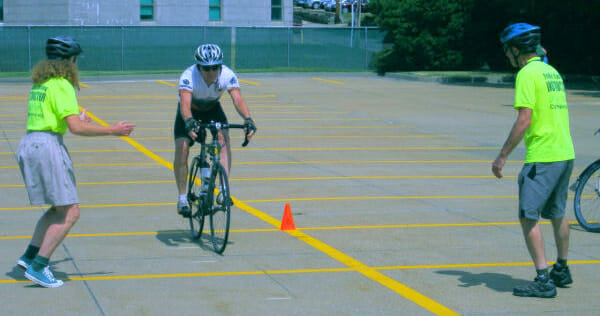
If you must brake suddenly, avoid pitching over the handlebars by sliding your weight back. We practice emergency stopping in “Train Your Bike,” CyclingSavvy’s bike handling skills session.
Front- and rear-wheel brakes may look the same, but they perform differently. Are you afraid of going over the handlebars if you brake too hard with the front brake? You’re not alone if you are. Lots of people avoid the front brake because it actually can send the rider over the bars. But it also has a lot more stopping power!
When you brake, weight shifts from the rear wheel to the front wheel. The rear brake alone has very little stopping power, limited to the rear wheel’s skidding. Using the front brake along with the rear allows the front wheel to contribute, as it is carrying additional weight.
But that’s where the danger lies. If all of your weight is off the rear wheel, it will lift. You and the bike can rotate over the front wheel. Yikes!
You can avoid this by shifting your weight back as you brake. If you start braking well ahead of time and gradually, this should not be necessary. But in an emergency, you may have to brake hard and fast. If you can train yourself to thrust your weight back behind the saddle (like the illustration above), you will stop in a shorter distance without flipping over the bars. Even with gradual braking, you’ll need to shift your weight back when you are going downhill (mountain bikers know this).
A future discussion of bicycling skills will go into more detail about developing braking technique.
Bicycling Skills: Cornering
To turn a bike, you turn the handlebars and the bike follows, right? Well, not really. That’s how you turn a car.
When you steer a bicycle to one side, it actually leans to the other side. You probably don’t notice this on low speed turns, because you subconsciously adjust the steering to maintain balance. Actually, you are just steering so the bike follows the turn that the lean already started.
Why does this matter?
At low speeds it doesn’t, much. Most cyclists ride for years without being aware of it. I did. But what happens when you’re cruising downhill and there’s a curve? Sure, you could slow down, and certainly you need to know your limits.
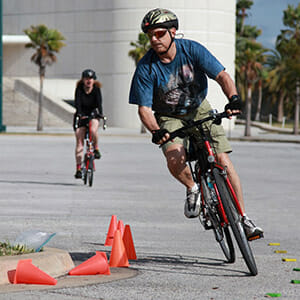
Inside pedal up. Look into the turn.
At higher speeds, starting the lean is harder. You can get the bike to help you by intentionally countersteering slightly to start. Briefly steering away from the turn will cause the bike to lean into the turn. So to initiate a right turn, push the handlebars very slightly and briefly left. Once the bike leans, just go with it. Turn your head and look into the turn; the bike will follow. It’s best to stop pedaling when making a sharp turn. When the bike is leaning, the inside pedal can hit the pavement at the bottom of the stroke. So once you initiate the lean, push the outside pedal down and keep it there.
It’s very important to look in the direction you are turning, because your body will naturally go where you’re looking. This will help you keep your turns tighter.
Beyond basic braking and turning
In case you want to go into more detail, this page from noted bicycle mechanic Sheldon Brown describes special circumstances in which to use one or the other brake, and different ways of leaning in a turn.
In the next article in this series, we take up the topic of effective use of gears.

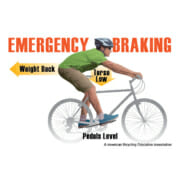
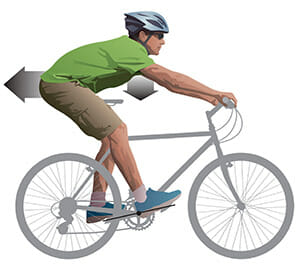
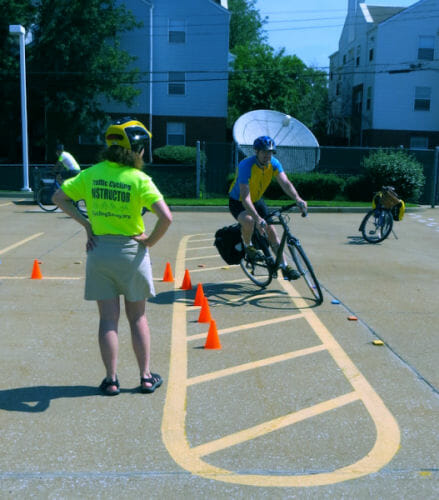
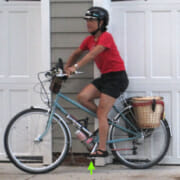


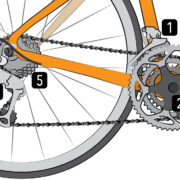
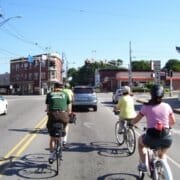
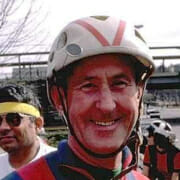

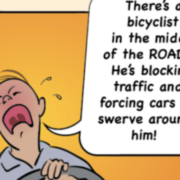



Yes, it is important to bank the turn when riding and especially with high speed turns. I guess bike riders do a little counter steering when they ride to bank a turn at high speeds. I have not notice the counter steer but many tricks to successful riding happens through experience on the road and sometimes it hard to notice exactly what has taken place. The counter steering must be quick and settle.
Nice article John!
I love how Kirby Beck (IPMBA Instructor & founding board member) describes what IPMBA calls “Maximum” Braking (formerly Emergency Braking):
In order and quickly, “Pedals (3 & 9 o’ clock), Butt (as far rearward and low as possible), the Brakes (both, but more application of the front).
CS